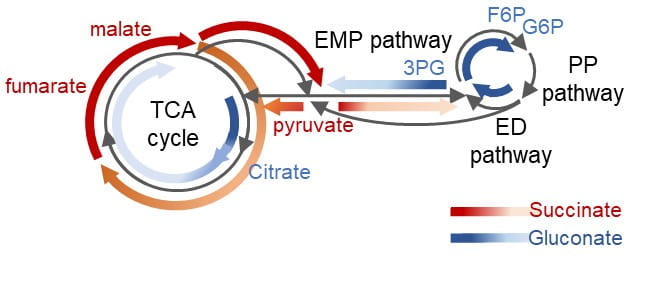TITLE: Analogous Metabolic Decoupling in Pseudomonas putida and Comamonas testosteroni Implies Energetic Bypass to Facilitate Gluconeogenic Growth
–ABSTRACT: Gluconeogenic carbon metabolism is not well understood, especially within the context of flux partitioning between energy generation and biomass production, despite the importance of gluconeogenic carbon substrates in natural and engineered carbon processing. Here, using multiple omics approaches, we elucidate the metabolic mechanisms that facilitate gluconeogenic fast-growth phenotypes in Pseudomonas putida and Comamonas testosteroni, two proteobacteria species with distinct metabolic networks. By contrast to the genetic constraint of C. testosteroni, which lacks the enzymes required for both sugar uptake and a complete oxidative pentose phosphate (PP) pathway, sugar metabolism in P. putida is known to generate surplus NADPH by relying on the oxidative PP pathway within its characteristic cyclic connection between the Entner-Doudoroff (ED) and Embden-Meyerhoff-Parnas (EMP) pathways. Remarkably, similar to the genome-based metabolic decoupling in C. testosteroni, our 13C-fluxomics reveals an inactive oxidative PP pathway and disconnected EMP and ED pathways in P. putida during gluconeogenic feeding, thus requiring transhydrogenase reactions to supply NADPH for anabolism in both species by leveraging the high tricarboxylic acid cycle flux during gluconeogenic growth. Furthermore, metabolomics and proteomics analyses of both species during gluconeogenic feeding, relative to glycolytic feeding, demonstrate a 5-fold depletion in phosphorylated metabolites, and the absence of or up to a 17-fold decrease in proteins of the PP and ED pathways. Such metabolic remodeling, which is reportedly lacking in Escherichia coli exhibiting a gluconeogenic slow-growth phenotype, may serve to minimize futile carbon cycling while favoring the gluconeogenic metabolic regime in relevant proteobacteria species. [Link to Article]
